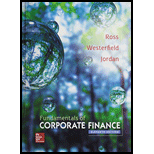
a)
To find: The maximum and minimum subscription price
Introduction:
The price at which the present shareholders of the company are authorized to purchase the common stock in a rights issue is a subscription price.
a)
Answer to Problem 2QP
The maximum subscription price is $52, the minimum price is anything higher than zero
Explanation of Solution
Given information:
Company C proposes a rights offering to raise $30 million for a new journal. The journal reviews the potential articles after the author makes the payment of the nonrefundable reviewing fee $5,000 for a page. The current price of the stock is $52 for a share and the outstanding shares is 3.9 million.
The maximum and the minimum subscription price:
The maximum subscription price is the current value of the stock or $52. The minimum subscription price is anything that is higher than $0.
Hence, the maximum subscription price is $52. The minimum subscription price is $0.
b)
To find: The number of the shares that must be sold and the number of rights that it will take to purchase a share.
Introduction:
The unit of ownership of a company is generally referred to as a share. The number of shares for each shareholder of the company differs.
b)
Answer to Problem 2QP
The number of shares that must be sold is 652,174 shares and the number of rights that is essential is 5.98 shares.
Explanation of Solution
Given information:
Company C proposes a rights offering to raise $30 million for a new journal. The journal reviews the potential articles after the author makes the payment of the nonrefundable reviewing fee $5,000 for a page. The current price of the stock is $52 for a share and the outstanding shares is 3.9 million.
Formula to compute the number of shares that must be sold:
Computation of the number of shares that must be sold:
Hence, the number of shares that must be sold is $652,174.
Formula to compute the numbers of rights needed:
Computation of the number of the rights needed:
Hence, the number of the rights needed is 5.98.
c)
To find: The price of the ex-rights and the value of a right
Introduction:
The shares of the traded stock that no longer have the rights attached to it because they might have expired, been exercised, or transferred to another investor is an ex-right shares. The mathematically computed value of the subscription right after the announcements of the offering and before the expiration of the rights is the value of rights.
c)
Answer to Problem 2QP
The price of the ex-rights is $51.14 and the value of a right is $0.86
Explanation of Solution
Given information:
Company C proposes a rights offering to raise $30 million for a new journal. The journal reviews the potential articles after the author makes the payment of the nonrefundable reviewing fee $5,000 for a page. The current price of the stock is $52 for a share and the outstanding shares is 3.9 million.
The price of the ex-rights and the value of the right:
A shareholder can purchase 5.98 rights-on share for:
The shareholder can exercise these rights for $46, the total cost of these rights are as follows:
The ex-rights share of the investors are as follows:
Hence, the number of rights needed is 1.98 rights for a share.
Formula to compute the price per share of the stock ex-rights:
N is the number of rights needed, PRO is the rights-on price, PS is the subscription price.
Computation of the ex-rights stock price:
Hence, the price of the ex-rights stock is $51.14.
Computation of the value of a right:
Note: N is the number of rights needed, PRO is the rights-on price, PX is the new price of the stock.
Hence, the value of a right is $0.86.
d)
To show: The rights offer does not harm the shareholder with 1,000 shares before the offering and had no intention to purchase additional share
Introduction:
The public issue of securities in which the securities are generally at an initial stage offered to the owners or the existing shareholders of the company is a right offer.
d)
Explanation of Solution
Given information:
Company C proposes a rights offering to raise $30 million for a new journal. The journal reviews the potential articles after the author makes the payment of the nonrefundable reviewing fee $5,000 for a page. The current price of the stock is $52 for a share and the outstanding shares is 3.9 million.
Explanation:
In advance to the offer, the shareholder will have the shares that are owned at the present price of the market or the portfolio value that is as follows:
After the offer there will be a fall in the share price but the shareholder will also hold the rights then the portfolio value is as follows:
Hence, the portfolio value before and after the offer is same $52,000.
Want to see more full solutions like this?
Chapter 15 Solutions
Fundamentals of Corporate Finance with Connect Access Card
